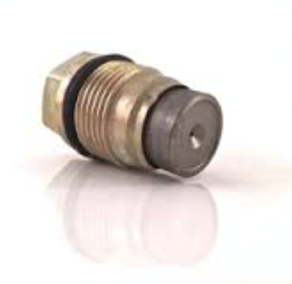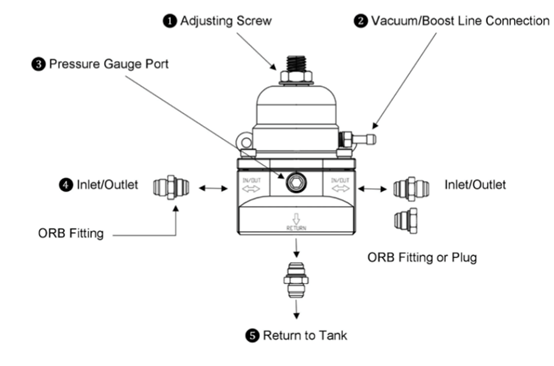The working principle of automobile electric fuel pump is basically the same as that of electric water pump. The fuel pump also feeds fuel to the fuel system. In order to maintain a certain pressure on the fuel system, the fuel can spray from the injector with good atomization effective and combustion efficiency by keeping the fuel pump working. When the engine shuts down, the fuel system does not lose all its pressure. In the case of high temperature, it is easy to generate air resistance in the fuel pipe. When the engine restarts, it will be difficult to start the engine due to the mixing air in the fuel system to ensure enough fuel. For this purpose, a one-way valve is set in the fuel pump. This way, when the fuel pump stops, the check valve closes to maintain residual pressure in the fuel line and facilitate the restart of the engine. If necessary, test the fuel pressure.
The function of fuel pressure regulating valve (a relief valve or pressure relief valve) ensures the normal operation of fuel pressure in the fuel circuit of automobile. There is a diaphragm inside the pressure regulator to control the opening and closing of the pressure valve. When the fuel pressure is lower than a certain value, the pressure valve will be closed and the pressure in the fuel pipe will be increased by pressurizing the fuel pump. When the pressure exceeds the specified level, the diaphragm will be opened and the over-pressured fuel will flow back to the oil tank through the return pipeline, playing a role of decompression.

If you have a faulty fuel pump, one of bad fuel pump symptoms is lower fuel pressure.The fuel pump should maintain the vehicle manufacturer’s recommended fuel pressure at all times. So check your owner’s manual for the recommended fuel pressure and then check your fuel pressure gauge for the reading. If its failing, it can’t always do that. If your vehicle has been sputtering and/or stalling, check the fuel pressure to confirm or deny it is a fuel pump problem. Low fuel pressure prevents the engine from cranking.
In addition, the driver may notice that when your car is parked for a long time, if the car is in relatively quiet circumstance at that time, when you turn on the ignition switch but not in a hurry to start the engine, you will hear a "buzzing" sound in the back of the car. But this is not a failure, but to ensure that the fuel system has enough pressure to start the engine smoothly, let the electric fuel pump run ahead of time for two to three seconds to establish the fuel pressure. The safety valve is designed to prevent damage caused by excessive pressure on one side of the outlet of the electric fuel pump. In this way, if the fuel pressure from the fuel pump is too high, the relief valve automatically opens, allowing the fuel pressure to return to the fuel tank.
The fuel pressure regulator is installed at the end of the fuel supply line to regulate the pressure coming into the injector. This pressure is maintained at a constant value of 300-350kPa, and not affected by the vacuum in the inlet pipe and the fuel pump pressure.
The fuel pressure regulator is a must have item for any EFI system, without it, the fuel rail will not be able to build up enough pressure to support the injectors with the sufficient amount of fuel, the fuel will instead flow straight through and not reach the injectors.
On the other hand, blocking the pass-through to the fuel tank off completely, the fuel pump will try to force too much fuel into the injectors which will cause them to fail. To accommodate for a successful fuel and air mixture, a proper fuel pressure is required in all situations, both at low revs and high revs, regardless of the power output. This is where the fuel pressure regulator is doing its job, to adapt the fuel supply to the fuel demand.
Tip
There is also a filter screen on the fuel pressure regulator. If the filter screen is blocked, the sound of air flowing will be heard in the fuel tank. The fuel filter can be cleaned with fuel detergent and then blow-drying with compressed air.
We can also remove the injector and fuel rail in all cylinders, and check the installation location whether have large amounts of carbon deposits and fuel impurities. If so, it also means that the filter screen on the fuel pressure regulator is clogged.
In the electronic fuel injection (EFI) system, the fuel pressure regulator is as below:

1.The regulator is designed with a threaded adjuster and locking nut at the top which alters the preload on the internal spring. Increasing the preload will increase the fuel pressure.
2. Vacuum port provides the boost/vacuum pressure to the top of the regulator.
3. Pressure port for attaching a fuel pressure gauge or sensor.
4. Fuel Inlet/Outlet. O-Ring should be facing the regulator side.
5. Excess fuel port. ORB fitting allows the bypassed fuel to return to the surge tank, fuel tank, or fuel cell.
A brief introduction of EFI
The Electronic fuel injection system fitted to most modern vehicles combines sophisticated computer controls with a high pressure fuel delivery system to provide optimum power and fuel efficiency. The system is controlled by an electronic control unit (ECU).
These systems often have anything in excess of thirty different engine and emission sensors all sending information continually to the ECU.
The ECU then monitors the information from the sensors and ensures the correct amount of fuel and air is used to provide optimum fuel efficiency and performance and also minimize exhaust emissions. To improve fuel efficiency and lower pollution levels, modern vehicles are fitted with electronic fuel injection (EFI) in place of the Carburettor.
Although complex in design, the basic principles of EFI are relatively simple, and usually offer years of trouble free motoring, provided regular maintenance procedures are observed.
 James Smith
James Smith  August 30, 2020
August 30, 2020